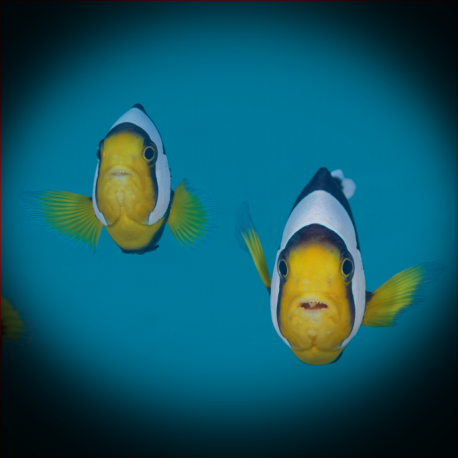More info
Datasheet
| Minimum Tank Size | 100 litres / 26.42 US gallons |
| Maximum Size | 13.0cm / 5.12inches |
| Reef Compatible | Always reef safe |
| Temperament | Might be aggressive towards similar species |
| Temperature | 22.2°C / 71.96°F - 25.6°C / 78.08°F |
| Specific Gravity | 1.020-1.025 |
| Carbonate Hardness | 8-12 |
| pH | 8.1-8.4 |
General DescriptionThe Saddle Brown Clownfish, also known as the Saddleback anemonefish, White-tipped anemonefish, or Saddleback clownfish, belongs to the Pomacentridae family under the subfamily Amphiprion. They have a distinct saddle-like marking on their body and come in shades ranging from orange to dark, with some even appearing black. Notable features include a white-edged tail and lack of white bands on the tail extending along the body to the dorsal fin.
Aquarium SuitabilitySaddle Brown Clownfish are generally suitable for most aquarium setups. They can be kept in pairs, with one female typically being larger than the male. It's crucial to avoid housing two females together as they do not tolerate each other. These clownfish are recommended for reef aquariums, but they may show aggression towards similar species, especially when protecting their territory or eggs.
Demands, Care, and HardinessWith an average hardiness level, Saddle Brown Clownfish thrive in water temperatures ranging from 22.2 to 25.6 degrees Celsius, a pH of 8.1-8.4, and a specific gravity of 1.020-1.025. They require a tank size of at least 100 liters and prefer alkalinity levels between 8-12 dKH. These clownfish are easy to care for and do not demand extensive swimming space, making them suitable for smaller tanks.
Reef SuitabilitySaddle Brown Clownfish are always reef-safe, making them an excellent choice for reef aquariums. They can exhibit territorial behavior, especially towards other fish that encroach on their hiding spots or when they have anemones or are carrying eggs.
Aquarium SetupWhen setting up an aquarium for Saddle Brown Clownfish, ensure the presence of suitable hiding spots such as anemones, Hammercoral, or Xenia. Providing a pair with appropriate space to establish their territory is important. These clownfish are best kept in male-female pairs or two males to one female to avoid aggression.
BehaviourSaddle Brown Clownfish typically form pairs and exhibit fascinating social behavior, especially when breeding or caring for eggs. They may display aggressive tendencies towards similar species or intruders near their territory.
Feeding and DietIn captivity, Saddle Brown Clownfish thrive on a diet of microalgae like spirulina, small crustaceans such as krill and mysis, and zooplankton like cyclops and pods. Feeding them multiple times a day with a varied diet is essential for their health and well-being.
Dimorphism and Captive ReproductionThese clownfish are known to change gender, with males transitioning into females. Normally, the female is the larger of the pair. Saddle Brown Clownfish can be successfully bred in captivity, making it possible to obtain captive-bred specimens from local fish stores.
Habitat and DistributionIn the wild, Saddle Brown Clownfish are found in the Western Pacific, including regions such as the Ryukyu Islands, China, Indonesia, Australia, and the Solomon Islands. They are commonly associated with various species of anemones and exhibit symbiotic behavior with these hosts in their natural habitat.

